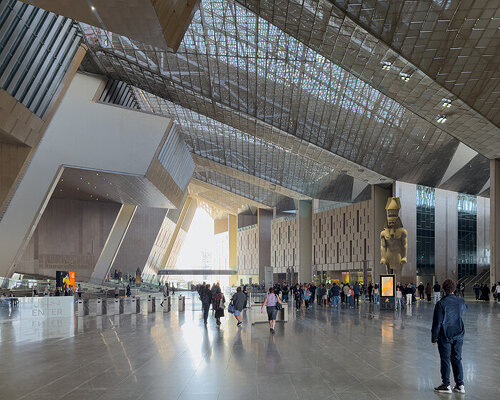the largest museum dedicated to a single culture
The Grand Egyptian Museum by heneghan peng architects has reached completion, standing just over a mile from the Pyramids of Giza. The vast complex is located on a desert plateau at the edge of Cairo, and stands as a bridge between the past and the present of the world’s most enduring civilizations. Housing 100,000 artifacts, it is the largest museum ever dedicated to a single culture.
From its entrance forecourt, the Museum extends outward toward the pyramids along a precise visual axis. The roofline rises in correspondence with the horizon of the three pyramids but never overtakes them. This composition frames the monuments as an ever-present backdrop, visible from within the museum’s grand rooms.
image © Iwan Baan
geometries draw from monumental context
With the design of the Grand Egyptian Museum, the architects at heneghan peng draw from the geometries embedded in its context. The museum’s internal walls radiate from a fixed point near the entrance to create a fanned floor plan that subtly directs movement toward the west. More than just a symbol, this organization informs light, circulation, and the visitor’s shifting relationship with the landscape.
The structure itself, largely cast in concrete, mediates the desert’s extreme conditions through mass and shade. This way, comfortable interior temperatures are achieved through the use of passive methods across the vast exhibition halls.
A monumental staircase runs through the building’s core, ascending six stories. The route moves from Egypt’s earliest settlements to its Coptic era, culminating in the Tutankhamen Gallery where over 5,000 artifacts are displayed together for the first time. This ascent through time is punctuated by statues and architectural fragments displayed along the landings.
image courtesy Grand Egyptian Museum
a sunlit museum wrapped in sand-toned concrete
Light is treated by heneghan peng architects with precision throughout its Grand Egyptian Museum. While conservation typically limits exposure to daylight, the stone-based nature of many exhibits allows filtered sunlight to enter through controlled apertures and skylights. This approach introduces a subtle and rhythmic illumination, and connects the interiors to the desert beyond.
With its envelope of locally-sourced limestone and sand-toned concrete, the building dissolves into its environment, catching and diffusing the shifting hues of the Giza plateau. The material palette extends even to performance. The dense concrete shell stabilizes fluctuating temperatures and reduces mechanical cooling demands. Meanwhile, the controlled use of glass and shading devices calibrates the transition between interior and exterior light levels.
image © Iwan Baan
Landscaped gardens designed with West 8 extend from the museum forecourt, framing views toward the pyramids while providing green space for Cairo’s residents. These gardens act as both buffer and a threshold between the museum and desert beyond.
Beneath the street level, an extensive network of laboratories and storage facilities supports the museum’s mission of preservation. Connected to the main building by tunnel, the conservation center is among the largest in the world, with specialized laboratories for papyrus, textiles, ceramics, sculpture, and human remains. This infrastructure emphasizes the Museum’s dual role as a public institution and a center for research, and ensures that Egypt’s material history continues to be preserved, studied, and shared with future generations.
image © Iwan Baan
image © Iwan Baan
image © Iwan Baan
image © Iwan Baan
image © Iwan Baan
project info:
name: Grand Egyptian Museum | @grandegyptianmuseum
architect: heneghan peng architects
location: Cairo, Egypt
client: Ministry of Culture, Egypt
size: 100,000 square meters (main museum and Conference Centre), 18,000 square meters (Conservation Centre), 11,000 square meters (Energy Centre)
completion:
photography: © Iwan Baan | @iwanbaan, courtesy Grand Egyptian Museum
local architect: Raafat Millier Consulting
structural/civic/traffic, facade engineering: Arup
local structural/civil traffic: Arab Consulting Engineers
building services, IT/security/fire/acoustics: Buro Happold
local building services: Shaker Consulting Engineers
landscape: West 8
local landscape: SITES
design team management, QS: Davis Langdon
specialist lighting: Bartenbach Lichlabor
signage & wayfinding: Bruce Mau Design
exhibition masterplanning: Metaphor
museology: Cultural Innovations
The post gazing onto the pyramids of giza, the grand egyptian museum set for november opening appeared first on designboom | architecture & design magazine.

